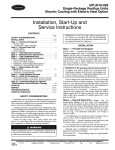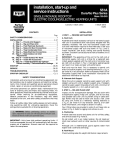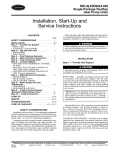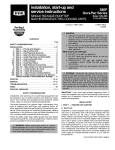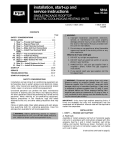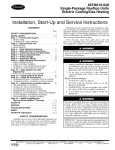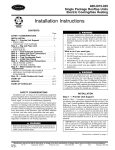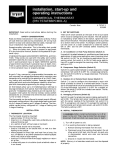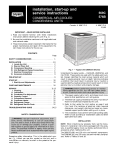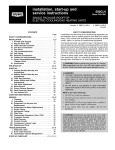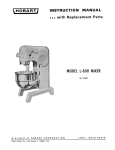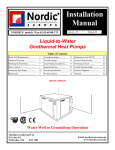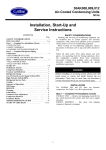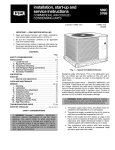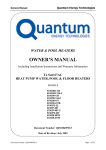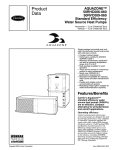Download Bryant 559F Air Conditioner User Manual
Transcript
installation, start-up and service instructions 559F SINGLE PACKAGE ROOFTOP ELECTRIC HEATING/ELECTRIC COOLING UNITS Cancels: II 559F-180-3 CONTENTS Sizes 180-300 15 to 25 Tons II 559F-180-4 10/15/98 INSTALLATION Page SAFETY CONSIDERATIONS . . . . . . . . . . . . . . . . . . . . . . . . 1 INSTALLATION . . . . . . . . . . . . . . . . . . . . . . . . . . . . . . . . . 1-15 I. Step 1 — Provide Unit Support . . . . . . . . . . . . . . . 1 II. Step 2 — Rig and Place Unit . . . . . . . . . . . . . . . . . 1 III. Step 3 — Field Fabricate Ductwork . . . . . . . . . . . . 7 IV. Step 4 — Make Unit Duct Connections . . . . . . . . . 7 V. Step 5 — Trap Condensate Drain . . . . . . . . . . . . . . 7 VI. Step 6 — Make Electrical Connections . . . . . . . . . 8 VII. Step 7 — Make Outdoor-Air Inlet Adjustments . . . . . . . . . . . . . . . . . . . . . . 11 VIII. Step 8 — Install Outdoor-Air Hood . . . . . . . . . . . 12 IX. Step 9 — Install All Accessories . . . . . . . . . . . . . 13 START-UP . . . . . . . . . . . . . . . . . . . . . . . . . . . . . . . . . . . . 15-20 SERVICE . . . . . . . . . . . . . . . . . . . . . . . . . . . . . . . . . . . . . 20-24 TROUBLESHOOTING . . . . . . . . . . . . . . . . . . . . . . . . . . . . 25 START-UP CHECKLIST . . . . . . . . . . . . . . . . . . . . . . . . . . CL-1 SAFETY CONSIDERATIONS Installation and servicing of air-conditioning equipment can be hazardous due to system pressure and electrical components. Only trained and qualified service personnel should install, repair, or service air-conditioning equipment. Untrained personnel can perform basic maintenance functions of cleaning coils and filters and replacing filters. All other operations should be performed by trained service personnel. When working on air-conditioning equipment, observe precautions in the literature, tags and labels attached to the unit, and other safety precautions that may apply. Follow all safety codes. Wear safety glasses and work gloves. Use quenching cloth for unbrazing operations. Have fire extinguishers available for all brazing operations. WARNING: Before performing service or maintenance operations on unit, turn off main power switch to unit. Electrical shock could cause personal injury. IMPORTANT: Units have high ambient operating limits. If limits are exceeded, the units will automatically lock the compressor out of operation. Manual reset will be required to restart the compressor. I. STEP 1 — PROVIDE UNIT SUPPORT A. Roof Curb Assemble and install accessory roof curb or horizontal adapter roof curb in accordance with instructions shipped with the curb or horizontal adapter. Accessory roof curb and horizontal adapter roof curb and information required to field fabricate a roof curb or horizontal adapter roof curb are shown in Fig. 1 and 2. Install insulation, cant strips, roofing, and counter flashing as shown. Ductwork can be secured to roof curb before unit is set in place. IMPORTANT: The gasketing of the unit to the roof curb or adapter roof curb is critical for a leak-proof seal. Install gasket supplied with the roof curb or adapter roof curb as shown in Fig. 1. Improperly applied gasket can result in air leaks and poor unit performance. Curb or adapter roof curb should be level. This is necessary to permit unit drain to function properly. Unit leveling tolerance is 6 1⁄16 in. per linear ft in any direction. Refer to Accessory Roof Curb or Horizontal Adapter Roof Curb Installation Instructions for additional information as required. B. Alternate Unit Support When the curb or adapter cannot be used, support unit with sleepers using unit curb or adapter support area. If sleepers cannot be used, support long sides of unit with a minimum of 3 equally spaced 4-in. x 4-in. pads on each side. II. STEP 2 — RIG AND PLACE UNIT Inspect unit for transportation damage. File any claim with transportation agency. Keep unit upright, and do not drop. Use spreader bars over unit to prevent sling or cable damage. Rollers may be used to move unit across a roof. Level by using unit frame as a reference; leveling tolerance is 6 1⁄16 in. per linear ft in any direction. See Fig. 3 for additional information. Unit weight is shown in Table 1. Four lifting holes are provided in ends of unit base rails as shown in Fig. 3. Refer to rigging instructions on unit. A. Positioning Provide clearance around and above unit for airflow, safety, and service access (Fig. 4 and 5). Do not install unit in an indoor location. Do not locate air inlets near exhaust vents or other sources of contaminated air. Although unit is weatherproof, guard against water from higher level runoff and overhangs. B. Roof Mount Check building codes for weight distribution requirements. PKG. NO. REF. 308450-201 CURB HEIGHT 18-29 (305) 308450-202 28-09 (610) 308450-203 28-09 (610) NOTES: 1. Roof curb accessory is shipped disassembled. 2. Insulated panels: 1⁄29 thick neoprene coated 2 lb density. 3. Dimensions in ( ) are in millimeters. DESCRIPTION Standard Curb 149 High Standard Curb for Units Requiring High Installation Side Supply and Return Kit for High Installation 4. Direction of airflow. 5. Roof curb: 16 ga. (VA03-56) stl. NOTE: To prevent the hazard of stagnant water build-up in the drain pan of the indoor section, unit can only be pitched as shown. UNIT LEVELING TOLERANCES* Dimensions (degrees and inches) UNIT —2— 559F A DEG. .28 *From edge of unit to horizontal. Fig. 1 — Roof Curb Details B IN. .45 DEG. .28 IN. .43 UNIT 559F 180 216 240 300 NOTE: For preassembled horizontal adapter roof curb part no. 389210-201, the accessory kit includes a factory-designed, highstatic, regain transition duct. For horizontal curb part no. 308450203, a field-supplied transition duct is required. MAXIMUM SHIPPING WEIGHT lb 1625 1725 1835 1985 kg 737 782 832 900 DIMENSIONS A ft-in. 6-111⁄2 6-111⁄2 6-111⁄2 6-111⁄2 B mm 2121 2121 2121 2121 ft-in. 4- 0 3-10 3- 7 3- 5 mm 1219 1168 1092 1041 NOTES: 1. Dimensions in ( ) are in millimeters. 2. Refer to Fig. 5 and 6 for unit operating weights. 3. Remove boards at ends of unit and runners prior to rigging. 4. Rig by inserting hooks into unit base rails as shown. Use corner post from packaging to protect coil from damage. Use bumper boards for spreader bars. 5. Weights do not include optional economizer. See Fig. 5 and 6 for economizer weight. 6. Weights given are for aluminum evaporator and condenser coil plate fins. For copper condenser coil add 150 lb (68 kg). For copper condenser and evaporator coils add 280 lb (127 kg). Fig. 2 — Horizontal Adapter Roof Curb and Roof Curb CAUTION: All panels must be in place when rigging. Fig. 3 — Rigging Details —3— UNIT STD UNIT WEIGHT ECONOMIZER WEIGHT CORNER A CORNER B CORNER C CORNER D DIM A DIM B mm DIM C Lb Kg Lb Kg Lb Kg Lb Kg Lb Kg Lb Kg ft-in. mm ft-in. ft-in. mm 559F180 1550 703 110 50 391 177 365 166 384 174 410 186 3-5 1041 3-6 1067 1-10 559 559F216 1650 748 110 50 399 181 384 174 402 182 439 199 3-4 1016 3-6 1067 1- 8 508 NOTES: 1. Refer to print for roof curb accessory dimensions. 2. Dimensions in ( ) are in millimeters. 3. Center of Gravity. 4. POWER EXHAUST/ BAROMETRIC RELIEF (ACCESSORY ONLY) —4— Fig. 4 — Base Unit Dimensions, 559F180 and 216 Direction of airflow. 5. Ductwork to be attached to accessory roof curb only. 6. Minimum clearance: • Rear: 78-09 (2134) for coil removal. This dimension can be reduced to 48-09 (1219) if conditions permit coil removal from the top. • Left side: 48-09 (1219) for proper condenser coil airflow. • Front: 48-09 (1219) for control box access. • Right side: 48-09 (1219) for proper operation of damper and power exhaust if so equipped. • Top: 68-09 (1829) to assure proper condenser fan operation. • Local codes or jurisdiction may prevail. 7. With the exception of clearance for the condenser coil and the damper/power exhaust as stated in Note #6, a removable fence or barricade requires no clearance. 8. Dimensions are from outside of corner post. Allow 08-5⁄169 (8) on each side for top cover drip edge. UNIT STD UNIT WEIGHT Lb ECONOMIZER WEIGHT CORNER A CORNER B CORNER C CORNER D Lb Kg Lb Kg Lb Kg Lb Kg Lb Kg 559F240 1700 771 110 50 419 190 394 179 425 193 463 559F300 1850 839 110 50 428 194 412 187 511 232 499 Kg DIM A DIM B ft-in. mm DIM C ft-in. mm ft-in. mm 210 3-4 1016 3-5 1041 1-8 508 226 3-2 965 3-7 1092 1-8 508 NOTES: 1. Refer to print for roof curb accessory dimensions. 2. Dimensions in ( ) are in millimeters. 3. Center of Gravity. 4. POWER EXHAUST/ BAROMETRIC RELIEF (ACCESSORY ONLY) —5— Fig. 5 — Base Unit Dimensions, 559F240 and 300 Direction of airflow. 5. Ductwork to be attached to accessory roof curb only. 6. Minimum clearance: • Rear: 78-09 (2134) for coil removal. This dimension can be reduced to 48-09 (1219) if conditions permit coil removal from the top. • Left side: 48-09 (1219) for proper condenser coil airflow. • Front: 48-09 (1219) for control box access. • Right side: 48-09 (1219) for proper operation of damper and power exhaust if so equipped. • Top: 68-09 (1829) to assure proper condenser fan operation. • Local codes or jurisdiction may prevail. 7. With the exception of clearance for the condenser coil and the damper/power exhaust as stated in Note #6, a removable fence or barricade requires no clearance. 8. Dimensions are from outside of corner post. Allow 08-5⁄169 (8) on each side for top cover drip edge. Table 1 — Physical Data UNIT 559F NOMINAL CAPACITY (tons) OPERATING WEIGHT COMPRESSOR Quantity ... Model (Ckt 1 , Ckt 2) 180 15 1550 2 81, 81 Rows...Fins/in. Total Face Area (sq ft) CONDENSER FAN Nominal Cfm Quantity...Diameter (in.) Motor Hp...Rpm Watts Input (Total) EVAPORATOR COIL 2...17 21.7 10-10 10-10 10,500 3...22 ⁄ ...1050 1100 12 Rows...Fins/in. Total Face Area (sq ft) EVAPORATOR FAN Quantity...Size (in.) Type Drive Nominal Cfm Motor Hp Motor Nominal Rpm Maximum Continuous Bhp Motor Bearing Type Maximum Allowable Rpm Motor Pulley Pitch Diameter Min/Max (in.) Nominal Motor Shaft Diameter (in.) Fan Pulley Pitch Diameter (in.) Nominal Fan Shaft Diameter (in.) Belt, Quantity...Type...Length (in.) 2...17 17.5 2...10 x 10 Belt 6000 3.7 1725 Low-Medium Static High Static Low-Medium Static High Static Low-Medium Static High Static Low-Medium Static High Static Pulley Center Line Distance (in.) Speed Change per Full Turn of Low-Medium Static Movable Pulley Flange (rpm) High Static Movable Pulley Maximum Full Turns From Closed Position Factory Speed Factory Speed Setting (rpm) Low-Medium Static High Static Fan Shaft Diameter at Pulley (in.) HIGH-PRESSURE SWITCH (psig) Cutout Reset (Auto) LOW-PRESSURE SWITCH (psig) Cutout Reset (Auto) FREEZE PROTECTION THERMOSTAT (F) Opens Closes OUTDOOR-AIR INLET SCREENS Quantity...Size (in.) RETURN-AIR FILTERS Quantity...Size (in.) POWER EXHAUST 240 20 1700 Scroll, Copeland 1...ZR108KC, 1...ZR125KC, 1...ZR94KC 1...ZR108KC 2 2 106,81 106, 106 R-22 TXV 2...ZR94KC Number of Refrigerant Circuits Oil (oz) (Ckt 1 , Ckt 2) REFRIGERANT TYPE Expansion Device Operating Charge (lb-oz) Circuit 1 * Circuit 2 CONDENSER COIL Motor Frame Size Nominal Rpm High/Low Fan Rpm Range 216 18 1650 4.25 56H — 891-1179 1227-1550 Ball 1550 3.1/4.1 3.7/4.7 7⁄8 6.0 5.2 13⁄16 1...BX...42 1...BX...42 13.5-15.5 48 55 5 3.5 1035 1389 13⁄16 300 25 1850 1...ZR16M3, 1...ZR125KC 2 136, 106 15-5 16-0 20-13 12-3 13-6 13- 0 Cross-Hatched 3⁄8-in. Copper Tubes, Aluminum Lanced, Aluminum Pre-Coated, or Copper Plate Fins 3...15 3...15 4...15 21.7 21.7 21.7 Propeller Type 10,500 14,200 14,200 3...22 2...30 2...30 1⁄2...1050 1...1075 1...1075 1100 3400 3400 Cross-Hatched 3⁄8-in. Copper Tubes, Aluminum Lanced or Copper Plate Fins, Face Split 3...15 3...15 4...15 17.5 17.5 17.5 Centrifugal Type 2...12 x 12 2...12 x 12 2...12 x 12 Belt Belt Belt 7200 8000 10,000 5 7.5 10 1745 1745 1740 8.7 [208/230 v] 10.2 [208/230 v] 5.90 9.5 [460 v] 11.8 [460 v] 184T 213T 215T — — — 910-1095 1002-1225 1066-1283 1069-1287 1193-1458 1332-1550 Ball Ball Ball 1550 1550 1550 4.9/5.9 5.4/6.6 4.9/5.9 4.9/5.9 5.4/6.6 4.9/5.9 1 1 ⁄8 13⁄8 13⁄8 9.4 9.4 8.0 8.0 7.9 6.4 7 7 1 ⁄16 1 ⁄16 17⁄16 1...BX...50 1...BX...53 2...BX...50 1...BX...48 1...BX...50 2...BX...47 13.3-14.8 14.6-15.4 14.6-15.4 37 37 36 34 44 45 5 5 5 3.5 3.5 3.5 1002 1120 1182 1178 1328 1470 17⁄16 17⁄16 17⁄16 426 320 27 44 30 ± 5 45 ± 5 Cleanable 2...20 x 25 x 1 1...20 x 20 x 1 Throwaway** 4...20 x 20 x 2 4...16 x 20 x 2 1⁄2 Hp, 208/230-460 v Motor Direct Drive, Propeller-Fan (Factory-Wired for 460 v) LEGEND Bhp — Brake Horsepower TXV — Thermostatic Expansion Valve *Circuit 1 uses the lower portion of the condenser coil and lower portion of the evaporator coils; and Circuit 2 uses the upper portion of both coils. †The 559F300 unit requires 2-in. industrial-grade filters capable of handling face velocities up to 625 ft/min (such as American Air Filter no. 5700 or equivalent). NOTE: The 559F units have a low-pressure switch (standard) located on the suction side. —6— III. STEP 3 — FIELD FABRICATE DUCTWORK IV. STEP 4 — MAKE UNIT DUCT CONNECTIONS Secure all ducts to building structure. Use flexible duct connectors between unit and ducts as required. Insulate and weatherproof all external ductwork, joints, and roof openings with counter flashing and mastic in accordance with applicable codes. Ducts passing through an unconditioned space must be insulated and covered with a vapor barrier. The 559F units with electric heat require a 1-in. clearance for the first 24 in. of ductwork. Outlet grilles must not lie directly below unit discharge. Unit is shipped for thru-the-bottom duct connections. Ductwork openings are shown in Fig. 6. Field-fabricated concentric ductwork may be connected as shown in Fig. 7 and 8. Attach all ductwork to roof curb and roof curb basepans. Refer to installation instructions shipped with accessory roof curb for more information. V. STEP 5 — TRAP CONDENSATE DRAIN See Fig. 4, 5, and 9 for drain location. Plug is provided in drain hole and must be removed when unit is operating. One 3⁄4-in. half coupling is provided inside unit evaporator section for condensate drain connection. An 81⁄2 in. x 3⁄4-in. diameter nipple and a 2-in. x 3⁄4-in. diameter pipe nipple are coupled to standard 3⁄4-in. diameter elbows to provide a straight path down through holes in unit base rails (see Fig. 10). A trap at least 4-in. deep must be used. NOTE: A 90-degree elbow must be provided in the ductwork to comply with UL (Underwriters’ Laboratories) codes for use with electric heat. WARNING: For vertical supply and return units, tools or parts could drop into ductwork and cause an injury. Install a 90 degree turn in the return ductwork between the unit and the conditioned space. If a 90 degree elbow cannot be installed, then a grille of sufficient strength and density should be installed to prevent objects from falling into the conditioned space. Due to electric heater, supply duct will require 90 degree elbow. Shaded area indicates block-off panels. NOTE: Dimension A, A8 and B, B8 are obtained from field-supplied ceiling diffuser. Fig. 8 — Concentric Duct Details NOTE: Do not drill in this area, as damage to basepan may result in water leak. Fig. 6 — Air Distribution — Thru-the-Bottom (559F216-300 Shown) 3/4" FPT DRAIN CONNECTION 1-3/8" DRAIN HOLES Fig. 9 — Condensate Drain Details (559F180,216 Shown) NOTE: Do not drill in this area, as damage to basepan may result in water leak. Fig. 7 — Concentric Duct Air Distribution (559F216-300 Shown) —7— This amount of phase imbalance is satisfactory as it is below the maximum allowable 2%. IMPORTANT: If the supply voltage phase imbalance is more than 2%, contact your local electric utility company immediately. Unit failure as a result of operation on improper line voltage or excessive phase imbalance constitutes abuse and may cause damage to electrical components. B. Field Control Wiring Install a Bryant-approved accessory thermostat assembly according to the installation instructions included with the accessory. Locate thermostat assembly on a solid wall in the conditioned space to sense average temperature. Fig. 10 — Condensate Drain Piping Details VI. STEP 5 — MAKE ELECTRICAL CONNECTIONS Route thermostat cable or equivalent single leads of no. 18 AWG (American Wire Gage) colored wire from subbase terminals through conduit in unit to low-voltage connections as shown on unit label wiring diagram and in Fig. 12. NOTE: For wire runs up to 50 ft, use no. 18 AWG insulated wire (35 C minimum). For 50 to 75 ft, use no. 16 AWG insulated wire (35 C minimum). For over 75 ft, use no. 14 AWG insulated wire (35 C minimum). All wire larger than no. 18 AWG cannot be directly connected to the thermostat and will require a junction box and splice at the thermostat. Set heat anticipator settings as indicated in Table 3. Settings may be changed slightly to provide a greater degree of comfort for a particular installation. Refer to accessory remote control instructions as required. A. Field Power Supply Unit is factory wired for voltage shown on nameplate. When installing units, provide a disconnect, per NEC (National Electrical Code) requirements, of adequate size (Table 2). All field wiring must comply with NEC and local requirements. Route power lines through control box access panel or unit basepan (Fig. 4 and 5) to connections as shown on unit wiring diagram and Fig. 11. Operating voltage to compressor must be within voltage range indicated on unit nameplate. On 3-phase units, voltages between phases must be balanced within 2% and the current must be balanced within 10%. CAUTION: The correct power phasing is critical in the operation of the scroll compressors. An incorrect phasing will cause the compressor to rotate in the wrong direction. This may lead to premature compressor failure. Use the following formula to determine the percentage of voltage imbalance. Percentage of Voltage Imbalance = 100 x max voltage deviation from average voltage average voltage EXAMPLE: Supply voltage is 460-3-60. TB1 MAXIMUM WIRE SIZE AB = 452 v BC = 464 v AC = 455 v UNIT 559F Average Voltage = = Determine maximum (AB) 457 − 452 = (BC) 464 − 457 = (AC) 457 − 455 = All 452 + 464 + 455 3 1371 VOLTAGE 208/230 350 kcmil 460 2/0 LEGEND EQUIP — Equipment NEC — National Electrical GND — Ground Code kcmil — Thousand Circular TB — Terminal Block Mils 3 = 457 deviation from average voltage: 5v 7v 2v Fig. 11 — Field Power Wiring Connections Maximum deviation is 7 v. Determine the percentage of voltage imbalance: Percentage of Voltage Imbalance = 100 x 7 457 = 1.53% UNIT LOW-VOLTAGE CONNECTIONS Fig. 12 — Field Control Thermostat Wiring —8— Table 2 — Electrical Data UNIT 559F COMPRESSOR VOLTAGE NOMINAL OFM RANGE VOLTAGE No. 1 No. 2 (3 Ph, 60 Hz) Min Max RLA LRA RLA LRA Qty Hp FLA (ea) Hp 208/230 187 253 28.8 195 28.8 195 3 0.5 1.7 460 414 508 14.7 95 14.7 95 3 0.5 0.8 208/230 187 253 30.1 225 28.8 195 3 0.5 1.7 460 414 508 15.5 114 14.7 95 3 0.5 0.8 208/230 187 253 37.8 239 30.1 225 2 1 6.6 460 414 508 17.2 125 15.5 114 2 1 3.3 180 (15 Tons) 216 (18 Tons) 240 (20 Tons) —9— IFM FLA POWER EXHAUST FLA — 4.6 — 4.6 3.7 10.5/11.0 — 4.6 — 4.6 — 2.3 — 2.3 3.7 4.8 — 2.3 — 2.3 — 4.6 — 4.6 5.0 15.8/15.8 — 4.8 — 4.6 — 2.3 — 2.3 5.0 7.9 — 2.3 — 2.3 — 4.6 — 4.6 7.5 25.0/25.0 — 4.6 — 4.6 — 2.3 — 2.3 7.5 13.0 — 2.3 — 2.3 LRA — 18.8 — 18.8 — 18.8 — 18.8 — 6.0 — 6.0 — 6.0 — 6.0 — 18.8 — 18.8 — 18.8 — 18.8 — 6.0 — 6.0 — 6.0 — 6.0 — 18.8 — 18.8 — 18.8 — 18.8 — 6.0 — 6.0 — 6.0 — 6.0 ELECTRIC HEAT* kW — — 26/34 26/34 42/56 42/56 56/75 56/75 — — 32 32 55 55 80 80 — — 26/34 26/34 42/56 42/56 56/75 56/75 — — 32 32 55 55 80 80 — — 26/34 26/34 42/56 42/56 56/75 56/75 — — 32 32 55 55 80 80 FLA — — 71/82 71/82 117/135 117/135 156/180 156/180 — — 39 39 66 66 96 96 — — 71/82 71/82 117/135 117/135 156/180 156/180 — — 39 39 66 66 96 96 — — 71/82 71/82 117/135 117/135 156/180 156/180 — — 39 39 66 66 96 96 POWER SUPPLY MCA 81/81 85/86 102/116 108/122 159/149 165/155 169/194 175/200 40 43 55 58 72 75 102 105 87/87 92/92 109/122 114/128 166/155 172/161 176/200 182/206 44 47 59 61 76 79 106 109 116/116 120/120 120/134 126/140 178/166 183/172 187/211 193/217 57 59 65 68 82 85 112 115 MOCP† 100/100 110/110 110/125 110/125 175/175 175/175 200/225 200/225 50 50 60 60 80 80 110 110 110/110 110/110 110/125 125/150 175/175 175/175 200/225 200/225 50 60 60 70 90 90 125 125 150/150 150/150 150/150 150/150 200/175 200/175 200/225 200/225 70 70 70 70 90 90 125 125 Table 2 — Electrical Data (cont) UNIT 559F COMPRESSOR VOLTAGE NOMINAL OFM RANGE VOLTAGE No. 1 No. 2 (3 Ph, 60 Hz) Min Max RLA LRA RLA LRA Qty Hp FLA (ea) 208/230 187 253 41.0 350 37.8 239 2 1 6.6 460 414 508 21.8 158 17.2 125 2 1 2.8 300 (25 Tons) FLA HACR IFM LRA MCA MOCP NEC OFM RLA — — — — — — — — — IFM Hp FLA POWER EXHAUST FLA — 4.6 — 4.6 10.0 28.0/28.0 — 4.6 — 4.6 — 2.3 — 2.3 10.0 14.6 — 2.3 — 2.3 LRA — 18.8 — 18.8 — 18.8 − 18.8 — 6.0 — 6.0 — 6.0 — 6.0 ELECTRIC HEAT* kW — — 26/34 26/34 42/56 42/56 56/75 56/75 — — 32 32 55 55 80 80 FLA — — 71/82 71/82 117/135 117/135 156/180 156/180 — — 39 39 66 66 96 96 POWER SUPPLY MCA 130/130 135/135 130/138 135/143 181/170 187/176 191/215 197/221 66 68 67 70 84 87 114 117 MOCP† 150/150 175/175 150/150 175/175 200/175 200/200 200/225 200/225 80 80 80 80 90 100 125 125 EXAMPLE: Supply voltage is 460-3-60. LEGEND Full Load Amps Heating, Air Conditioning and Refrigeration Indoor (Evaporator) Fan Motor Locked Rotor Amps Minimum Circuit Amps Maximum Overcurrent Protection National Electrical Code Outdoor (Condenser) Fan Motor Rated Load Amps AB = 452 v BC = 464 v AC = 455 v Average Voltage = = 452 + 464 + 455 3 1371 3 = 457 *Heater capacity (kW) is based on heater voltage of 208 v, 240 v, and 480 v. Heaters are rated at 240 v and 480 v. If power distribution voltage to unit varies from rated heater voltage, heater kW will vary accordingly. †Fuse or HACR circuit breaker. NOTES: 1. In compliance with NEC requirements for multimotor and combination load equipment (refer to NEC Articles 430 and 440), the overcurrent protective device for the unit shall be fuse or HACR breaker. The Canadian units may be fuse or circuit breaker. 2. Unbalanced 3-Phase Supply Voltage Never operate a motor where a phase imbalance in supply voltage is greater than 2%. Use the following formula to determine the percent of voltage imbalance. % Voltage Imbalance = max voltage deviation from average voltage 100 x average voltage Determine maximum deviation from average voltage. (AB) 457 − 452 = 5 v (BC) 464 − 457 = 7 v (AC) 457 − 455 = 2 v Maximum deviation is 7 v. Determine percent of voltage imbalance. 7 % Voltage Imbalance = 100 x 457 = 1.53% This amount of phase imbalance is satisfactory as it is below the maximum allowable 2%. IMPORTANTIf the supply voltage phase imbalance is more than 2%, contact your local electric utility company immediately. 3. MCA calculation for units with electric heaters over 50 kW = (1.25 x IFM amps) + (1.00 x heater FLA). —10— VII. STEP 7 — MAKE OUTDOOR-AIR INLET ADJUSTMENTS Table 3 — Heat Anticipator Settings A. Manual Outdoor-Air Damper UNIT 559F All units (except those equipped with a factory-installed economizer) have a manual outdoor-air damper to provide ventilation air. Damper can be preset to admit up to 25% outdoor air into return-air compartment. To adjust, loosen securing screws and move damper to desired setting. Then retighten screws to secure damper (Fig. 13). B. Optional Economizer Economizer Motor Control Module (Fig. 14-16) Set to the ‘‘D’’ setting (Fig. 15). The control module is located on the economizer motor. See Fig. 14 and 16. UNIT VOLTAGES 208/230-3-60 180-300 460-3-60 kW* STAGE 1 STAGE 2 26/34 42/56 56/75 32 55 80 .40 .66 .66 .40 .40 .66 .66 .40 .66 .40 .66 .66 *Heater kW is based on heater voltage of 208 v, 240 v and 480 v. Damper Vent Position Setting 1. Set fan switch at ON position (continuous fan operation) and close night switch if used. 2. Set system selector switch to OFF position. 3. Turn adjustment screw slowly until dampers assume desired vent position. Do not manually operate economizer motor since damage to motor will result. LEGEND LED — Light-Emitting Diode Fig. 15 — Economizer Control Module (Part Number W7459A) Fig. 13 — 25% Outdoor-air Section Details Fig. 16 — Economizer Control Module Location Fig. 14 — Economizer Damper Assembly — End View —11— VIII. STEP 8 — INSTALL OUTDOOR-AIR HOOD BAFFLE (300 ONLY) The same type of factory-installed hood is used on units with 25% air ventilation and units with an economizer. NOTE: The hood top panel, upper and lower filter retainers, hood drain pan, baffle (size 300), and filter support bracket are secured opposite the condenser end of the unit. The screens, hood side panels, remaining section of filter support bracket, seal strip, and all other hardware are in a package located inside the return-air filter access panel (Fig. 17). LOWER FILTER RETAINER FILTER SUPPORT BRACKET 1. Attach seal strip to upper filter retainer. See Fig. 18. 2. Assemble hood top panel and side panels, upper filter retainer, and hood drain pan (Fig. 19). 3. Secure lower filter retainer and long section of filter support bracket to unit. See Fig. 19. Leave screws loose on size 300 units. 4. Slide baffle (size 300) unit behind lower filter retainer and tighten screws. 5. Loosen sheet metal screws for base unit top panel located above outdoor-air inlet opening, and remove screws for hood side panels located on the sides of the outdoorair inlet opening. 6. Match notches in hood top panel to unit top panel screws. Insert hood flange between unit top panel flange and unit. Tighten screws. 7. Hold hood side panel flanges flat against unit, and install screws removed in Step 5. 8. Insert outdoor-air inlet screens and spacer in channel created by lower filter retainer and filter support bracket. 9. Attach remaining short section of filter support bracket. HOOD TOP PANEL HOOD SIDE PANELS (2) BAFFLE (300 ONLY) LOWER FILTER RETAINER FILTER SUPPORT BRACKET HOOD DRAIN PAN UPPER FILTER RETAINER NOTE: The outdoor-air hood comes with a baffle which is used on size 300 units only; discard baffle for 180-240 units. Fig. 19 — Outdoor-Air Hood Details Fig. 17 — Outdoor-Air Hood Component Location Fig. 18 — Seal Strip Location (Air Hood Cross-Sectional View) A. Enthalpy Control Installation NOTE: The accessory outdoor-air enthalpy sensor must be installed BEFORE the economizer hoods are installed on the unit or hoods will have to be removed. 1. Remove and discard the factory-installed jumper assembly containing the 800-ohm resistor on the economizer control module (between terminals SR and +). See Fig. 15. 2. Remove black wire assembly containing the 620-ohm resistor from between economizer control module terminal SO and the outdoor-air thermostat (OAT). Place this wire assembly (containing the 620-ohm resistor) between economizer control module terminals SR and +, replacing the jumper removed in Step 1. See Fig. 15. 3. Disconnect the blue wire from the OAT. 4. Remove OAT from the outside of the economizer (see Fig. 14). 5. Mount the enthalpy sensor (Fig. 20) to the economizer on the outside of the unit (in the same location from which the OAT was removed) using the 2 screws provided. See Fig. 14. 6. Reconnect the blue wire removed in Step 3 to the enthalpy sensor terminal +. 7. Cut the violet wire provided to desired length and terminate with quick-connect terminal provided. Route the violet wire from the enthalpy sensor terminal S, through the snap bushing, and to the economizer control module terminal SO . See Fig. 15. 8. Set changeover set point to the desired location. See Fig. 21. —12— NOTE: For maximum benefit of outdoor air, set the enthalpy control to the ‘‘A’’ setting. At this setting, when the relative humidity is 50% and the outdoor air is below 74 F, the relay contacts on the sensor will be closed. 3. Remove OAT and black wire assembly containing the 620-ohm resistor from the outside of the economizer (see Fig. 14). 4. Mount the outdoor-air enthalpy sensor (first sensor) to the economizer on the outside of the unit (in the same location from which the OAT was removed) using the 2 screws provided. See Fig. 14. 9. Reinstall economizer hoods if removed. IMPORTANT: Be sure all seal strips and RTV sealant are intact. A watertight seal to inside of unit must be maintained. 5. Reconnect the blue wire removed in Step 2 to the enthalpy sensor terminal +. 6. Cut the violet wire provided to desired length and terminate with quick-connect terminal provided. Route the violet wire from the enthalpy sensor terminal S, through the snap bushing, and to the economizer control module terminal SO. + 7. Mount the second enthalpy sensor in the return-air duct (return-air sensor). 8. Route the blue wire (provided) from terminal + on the return-air enthalpy sensor to the economizer control module terminal +. 9. Route the violet wire (provided) from terminal S on the return-air enthalpy sensor to the economizer control module terminal SR. 10. Turn changeover set point dial clockwise past the ‘‘D’’ setting, or the control will not operate on a differential. See Fig. 15. 11. Reinstall economizer hood if removed. Fig. 20 — Outdoor-Air and Return-Air Enthalpy Sensor POINT CONTROL CONTROL (Approx Deg) CURVE AT 50% RH A 73 B 68 C 63 D 58 IMPORTANT: Be sure all seal strips and RTV sealant are intact. A watertight seal to inside of unit must be maintained. IX. STEP 9 — INSTALL ALL ACCESSORIES After all the factory-installed options have been adjusted, install all field-installed accessories. Refer to the accessory installation instructions included with each accessory. A. MotormasterT I Control Installation (559F180 and 216) Install Field-Fabricated Wind Baffles Wind baffles must be field-fabricated for all units to ensure proper cooling cycle operation at low ambient temperatures. See Fig. 22 for baffle details. Use 20-gage, galvanized sheet metal, or similar corrosion-resistant metal for baffles. Use fieldsupplied screws to attach baffles to unit. Screws should be 1⁄4-in. diameter and 5⁄8-in. long. Drill required screw holes for mounting baffles. CAUTION: To avoid damage to the refrigerant coils and electrical components, use recommended screw sizes only. Use care when drilling holes. RH — Relative Humidity Fig. 21 — Psychrometric Chart for Solid-State Enthalpy Control B. Differential Enthalpy Control NOTE: The accessory outdoor-air enthalpy sensor must be installed BEFORE the economizer hoods are installed on the unit or hoods will have to be removed. 1. Remove and discard the factory-installed jumper assembly containing the 800-ohm resistor on the economizer control module (between terminals SR and +. See Fig. 15. 2. Disconnect black wire from economizer control module terminal SO and blue wire from the OAT (outdoor-air thermostat). Install Motormastert I Controls Only one Motormaster I control is required per unit. The Motormaster I control must be used in conjunction with the Accessory 0° F Low Ambient Kit (purchased separately). The Motormaster I device controls outdoor fan no. 1 while outdoor fans no. 2 and 3 are sequenced off by the Accessory 0° F Low Ambient Kit. Accessory 0° F Low Ambient Kit — Install the Accessory 0° F Low Ambient Kit per instruction supplied with accessory. Motor Mount — To ensure proper fan height, replace the existing motor mount with the new motor mount provided with accessory. —13— Install Motormaster III Controls Only one Motormaster III control is required per unit. Sensor — Install the sensor for thermistor input control in the location shown in Fig. 24. Connect sensor leads to the purple and grey control signal leads on the Motormaster III control. Signal Selection Switch — Remove the cover of the Motormaster III control. Set the switch to accept the thermistor sensor input signal. Set the frequency to match the unit power supply (60 Hz). Motormaster III Control — Recommended mounting location is beneath the control box, mounted to the partition that separates the control box section from the indoor section. NOTE: If unit power is supplied through the roof curb and basepan of the unit, mount the Motormaster III control on the corner post adjacent to the conduit running from the basepan to the bottom of the control box. NOTE: Dimensions in ( ) are in mm. Fig. 22 — Wind Baffle Details Transformer (460-v Units Only) — On 460-v units, a transformer is required. The transformer is provided with the accessory and must be field-installed. Sensor Assembly — Install the sensor assembly in the location shown in Fig. 23. Motormastert I Control — Recommended mounting location is on the inside of the panel to the left of the control box. The control should be mounted on the inside of the panel, vertically, with leads protruding from bottom of extrusion. B. Motormaster III Control Installation (559F240 and 300) Install Field-Fabricated Wind Baffles Wind baffles must be field-fabricated for all units to ensure proper cooling cycle operation at low ambient temperatures. See Fig. 22 for baffle details. Use 20-gage, galvanized sheet metal, or similar corrosion-resistant metal for baffles. Use fieldsupplied screws to attach baffles to unit. Screws should be 1⁄4-in. diameter and 5⁄8-in. long. Drill required screw holes for mounting baffles. CAUTION: To avoid damage to the refrigerant coils and electrical components, use recommended screw sizes only. Use care when drilling holes. SENSOR LOCATION SENSOR LOCATION HAIRPIN END HAIRPIN END 559F180 559F216 NOTE: All sensors are located on the eighth hairpin up from the bottom. Fig. 23 — Motormaster I Sensor Locations Replace Outdoor Motor Replace outdoor fan motor no. 1 with motor included in accessory kit. Existing motor is not Motormaster III compatible. —14— addition, Schrader-type valves are located underneath the lowpressure switches. Be sure that caps on the ports are tight. VII. COMPRESSOR ROTATION It is important to be certain the compressors are rotating in the proper direction. To determine whether or not compressors are rotating in the proper direction: 1. Connect service gages to suction and discharge pressure fittings. 2. Energize the compressor. 3. The suction pressure should drop and the discharge pressure should rise, as is normal on any start-up. If the suction pressure does not drop and the discharge pressure does not rise to normal levels: 1. Note that the evaporator fan is probably also rotating in the wrong direction. 2. Turn off power to the unit. SENSOR LOCATION 3. Reverse any two of the incoming power leads. SENSOR LOCATION HAIRPIN END 4. Turn on power to the compressor. The suction and discharge pressure levels should now move to their normal start-up levels. NOTE: When compressors are rotating in the wrong direction, the unit will have increased noise levels and will not provide heating and cooling. After a few minutes of reverse operation, the scroll compressor internal overload protection will open, which will activate the unit’s lockout and requires a manual reset. Reset is accomplished by turning the thermostat on and off. HAIRPIN END 559F240 559F300 NOTE: All sensors are located on the eighth hairpin up from the bottom. Fig. 24 — MotormasterT III Sensor Locations START-UP Use the following information and Start-Up Checklist on page CL-1 to check out unit PRIOR to start-up. I. UNIT PREPARATION Check that unit has been installed in accordance with these installation instructions and all applicable codes. VIII. EVAPORATOR FAN Fan belt and variable pulleys are factory installed. Remove tape from the fan pulley. See Table 4 for Air Quantity Limits. See Tables 5-7 for Fan Performance data. Be sure that fans rotate in the proper direction. See Tables 8 and 9 for Static Pressure information for accessories and options. See Table 10 for fan rpm at various fan motor pulley settings. To alter fan performance, see Evaporator-Fan Performance Adjustment section, page 21. Table 4 — Air Quantity Limits UNIT 559F 180 216 240 300 II. SERVICE VALVES Ensure that optional suction, discharge, and standard liquid line service valves are open. Damage to the compressor could result if they are left closed. III. INTERNAL WIRING Check all electrical connections in unit control boxes; tighten as required. IV. CRANKCASE HEATER(S) Heater(s) is energized as long as there is power to unit and compressor is operating. IMPORTANT: Unit power must be on for 24 hours prior to start-up. Otherwise, damage to compressor may result. V. COMPRESSOR MOUNTING Compressors are internally spring mounted. Do not loosen or remove compressor holddown bolts. VI. REFRIGERANT SERVICE PORTS Each refrigerant system has a total of 3 Schrader-type service gage ports. One port is located on the suction line, one on the compressor discharge line, and one on the liquid line. In MINIMUM CFM 4500 5400 6000 7000 MAXIMUM CFM 7,500 9,000 10,000 11,250 IX. CONDENSER FANS AND MOTORS Fans and motors are factory set. Refer to Condenser-Fan Adjustment section (page 22) as required. X. RETURN-AIR FANS Check that correct filters are installed in filter tracks. See Table 1. Do not operate unit without return-air filters. XI. OUTDOOR-AIR INLET SCREENS Outdoor-air inlet screens must be in place before operating unit. XII. ACCESSORY ECONOMIZER ADJUSTMENT Remove filter access panel. Check that outdoor-air damper is closed and return-air damper is open. Economizer operation and adjustment is described in Base Unit Operation and Economizer Adjustment sections (pages 20 and 22), respectively. —15— Table 5 — Fan Performance — 559F180 559F180 (15 TONS) Airflow (Cfm) 4500 4800 5100 5400 5700 6000 6300 6600 6900 7200 7500 Rpm 684 715 747 779 812 845 878 912 946 981 1016 0.2 Bhp 1.28 1.47 1.67 1.90 2.14 2.40 2.68 2.98 3.29 3.63 3.99 Watts 1102 1265 1442 1635 1844 2068 2309 2566 2841 3133 3443 Rpm 791 817 844 872 901 931 961 992 1023 1055 1087 0.4 Bhp 1.49 1.68 1.89 2.12 2.37 2.64 2.92 3.22 3.55 3.89 4.25 Watts 1283 1451 1633 1831 2044 2273 2518 2780 3059 3355 3669 Available External Static Pressure 0.6 0.8 Rpm Bhp Watts Rpm Bhp 887 1.70 1466 977 1.92 910 1.90 1638 997 2.12 934 2.12 1825 1018 2.34 959 2.35 2027 1040 2.58 985 2.60 2245 1063 2.84 1011 2.87 2478 1087 3.11 1039 3.16 2728 1112 3.41 1067 3.47 2994 1138 3.72 1096 3.80 3277 1165 4.05 1125 4.15 3578 — — — — — — — (in. wg) Watts 1652 1828 2019 2226 2448 2685 2939 3209 3496 — — Rpm 1061 1078 1097 1117 1138 1160 1183 1207 1232 — — 1.0 Bhp 2.13 2.34 2.57 2.81 3.07 3.35 3.65 3.97 4.31 — — Watts 1841 2021 2216 2426 2652 2893 3151 3425 3716 — — Rpm 1139 1155 1171 1189 1209 1229 1250 1273 — — — 1.2 Bhp 2.36 2.57 2.80 3.05 3.31 3.60 3.90 4.22 — — — Watts 2034 2217 2416 2629 2858 3103 3365 3642 — — — 559F180 (15 TONS) (cont) Airflow (Cfm) 4500 4800 5100 5400 5700 6000 6300 6600 6900 7200 7500 Rpm 1214 1228 1243 1259 1277 1295 1315 — — — — 1.4 Bhp 2.59 2.80 3.04 3.29 3.56 3.84 4.15 — — — — Watts 2230 2417 2618 2835 3067 3316 3580 — — — — Rpm 1285 1297 1311 1326 1342 1359 — — — — — Available External Static Pressure (in. 1.6 1.8 Bhp Watts Rpm Bhp Watts Rpm 2.82 2430 1353 3.05 2633 1386 3.04 2619 1364 3.27 2825 1396 3.27 2823 1376 3.51 3031 1408 3.53 3043 1390 3.77 3254 1421 3.80 3278 1405 4.05 3492 1435 4.09 3530 1421 4.34 3746 — — — — — — — — — — — — — — — — — — — — — — — — — — — —— — — — LEGEND Bhp — Brake Horsepower FIOP — Factory-Installed Option Watts — Input Watts to Motor NOTES: 1. Standard low-medium static drive range is 891 to 1179 rpm. Alternate high-static drive range is 1227 to 1550. Other rpms require a field-supplied drive. 2. Maximum continuous bhp is 4.25 and the maximum continuous watts are 3775. Do not adjust motor rpm such that motor maximum bhp and/or watts is exceeded at the maximum operating cfm. wg) 1.9 Bhp 3.17 3.40 3.64 3.90 4.17 — — — — — — Watts 2736 2928 3136 3360 3600 — — — — — — Rpm 1418 1428 1439 1452 1466 — — — — — — 2.0 Bhp 3.29 3.52 3.76 4.02 4.30 — — — — — — Watts 2839 3033 3242 3467 3708 — — — — — — 3. Static pressure losses (i.e., economizer) must be added to external static pressure before entering Fan Performance table. 4. Interpolation is permissible. Do not extrapolate. 5. Fan performance is based on wet coils, clean filters, and casing losses. See Table 8 for accessory/FIOP static pressure information. 6. Extensive motor and drive testing on these units ensures that the full horsepower and watts range of the motor can be utilized with confidence. Using your fan motors up to the watts or bhp rating shown will not result in nuisance tripping or premature motor failure. Unit warranty will not be affected. 7. Use of a field-supplied motor may affect wiring size. Contact your Bryant representative for details. —16— Table 6 — Fan Performance — 559F216 and 240 559F216 and 240 (18 and 20 TONS) Airflow (Cfm) 5,500 6,000 6,500 7,000 7,500 8,000 8,500 9,000 9,500 10,000 Rpm 682 730 778 828 878 928 979 1030 1082 1134 0.2 Bhp 1.99 2.38 2.82 3.31 3.84 4.42 5.05 5.73 6.46 7.25 Watts 1675 2005 2373 2780 3227 3715 4245 4817 5433 6093 Rpm 760 802 846 892 938 985 1033 1082 1131 1180 0.4 Bhp 2.29 2.68 3.13 3.62 4.15 4.74 5.38 6.06 6.80 7.59 Watts 1922 2257 2630 3042 3494 3986 4521 5098 5718 6382 559F216 and 240 (18 and 20 TONS) (cont) Available Airflow 1.4 1.6 (Cfm) Rpm Bhp Watts Rpm Bhp Watts 5,500 1086 3.89 3275 1142 4.24 3567 6,000 1112 4.31 3623 1167 4.66 3915 6,500 1142 4.77 4010 1194 5.12 4304 7,000 1173 5.28 4438 1224 5.63 4733 7,500 1207 5.83 4906 1255 6.19 5203 8,000 1242 6.44 5415 1289 6.80 5714 8,500 1279 7.10 5966 1324 7.45 6268 9,000 1317 7.80 6561 1360 8.16 6865 9,500 1356 8.56 7198 1398 8.93 7505 10,000 1397 9.37 7881 1438 9.74 8190 Available External Static Pressure 0.6 0.8 Rpm Bhp Watts Rpm Bhp 832 2.59 2177 901 2.90 871 2.99 2516 935 3.31 911 3.44 2893 972 3.76 953 3.94 3310 1011 4.26 996 4.48 3766 1051 4.81 1040 5.07 4263 1093 5.40 1085 5.71 4801 1136 6.05 1131 6.40 5382 1180 6.74 1178 7.14 6007 1225 7.49 1226 7.94 6675 1270 8.29 External Static 1.8 Rpm Bhp 1197 4.59 1219 5.01 1245 5.47 1273 5.98 1302 6.55 1334 7.16 1368 7.82 1403 8.53 1440 9.29 1477 10.11 LEGEND Bhp — Brake Horsepower FIOP — Factory-Installed Option Watts — Input Watts to Motor NOTES: 1. Standard low-medium static drive range for the 216 size is 910 to 1095 rpm. Standard low-medium static drive range for the 240 size is 1002 to 1225 rpm. Alternate high-static drive range for the 216 size is 1069 to 1287. Alternate high-static drive range for the 240 size is 1193 to 1458 rpm. Other rpms require a field-supplied drive. 2. Maximum continuous bhp for the 216 size is 5.90. Maximum continuous bhp for the 240 size is 8.7 (208/230 v) or 9.5 (460 v). The maximum continuous watts for the 216 size is 5180. The maximum continuous watts for the 240 size is 7915 (208/230 v) or 8640 (460 v). Do not adjust motor rpm such that motor maximum bhp and/or watts is exceeded at the maximum operating cfm. Pressure (in. wg) 1.9 Watts Rpm Bhp 3864 1223 4.77 4213 1245 5.19 4602 1270 5.65 5033 1296 6.17 5504 1326 6.73 6018 1357 7.34 6573 1389 8.00 7173 1424 8.71 7815 1460 9.48 8503 — — (in. wg) Watts 2441 2783 3164 3583 4043 4544 5086 5671 6299 6971 Watts 4015 4364 4754 5184 5657 6171 6728 7328 7972 — Rpm 965 997 1031 1067 1105 1144 1185 1227 1270 1313 Rpm 1249 1270 1294 1320 1348 1379 1411 1445 1480 — 1.0 Bhp 3.22 3.63 4.09 4.59 5.14 5.74 6.39 7.09 7.84 8.65 2.0 Bhp 4.96 5.37 5.83 6.35 6.91 7.52 8.18 8.90 9.67 — Watts 2712 3057 3440 3863 4326 4830 5375 5964 6595 7271 Rpm 1027 1056 1087 1121 1156 1194 1232 1272 1313 1356 1.2 Bhp 3.56 3.97 4.43 4.93 5.49 6.09 6.74 7.44 8.20 9.01 Watts 2990 3337 3722 4148 4613 5120 5669 6260 6895 7574 Watts 4167 4516 4906 5337 5810 6325 6883 7484 8129 — 3. Static pressure losses (i.e., economizer) must be added to external static pressure before entering Fan Performance table. 4. Interpolation is permissible. Do not extrapolate. 5. Fan performance is based on wet coils, clean filters, and casing losses. See Table 9 for accessory/FIOP static pressure information. 6. Extensive motor and drive testing on these units ensures that the full horsepower and watts range of the motor can be utilized with confidence. Using your fan motors up to the watts or bhp rating shown will not result in nuisance tripping or premature motor failure. Unit warranty will not be affected. 7. Use of a field-supplied motor may affect wiring size. Contact your Bryant representative for details. —17— Table 7 — Fan Performance — 559F300 559F300 (25 TONS) Airflow (Cfm) 7,000 7,500 8,000 8,500 9,000 9,500 10,000 10,500 11,000 11,250 Rpm 845 896 948 1001 1053 1106 1159 1213 1266 1293 Available External Static Pressure 0.2 0.4 0.6 0.8 Bhp Watts Rpm Bhp Watts Rpm Bhp Watts Rpm Bhp 3.26 2693 909 3.60 2979 969 3.96 3272 1028 4.32 3.82 3156 956 4.17 3450 1014 4.54 3752 1069 4.91 4.43 3667 1005 4.80 3969 1060 5.17 4278 1112 5.56 5.11 4226 1054 5.49 4537 1106 5.87 4853 1156 6.26 5.85 4836 1104 6.23 5155 1154 6.63 5478 1202 7.02 6.65 5498 1155 7.04 5824 1202 7.44 6155 1248 7.85 7.52 6214 1206 7.92 6547 1251 8.33 6886 1295 8.74 8.45 6984 1257 8.86 7325 1300 9.28 7671 1342 9.70 9.45 7810 1309 9.87 8159 1350 10.29 8511 1391 10.73 9.97 8245 1334 10.40 8597 1375 10.83 8953 1415 11.26 559F300 (25 TONS) (cont) Available External Static Pressure (in. wg) Airflow 1.4 1.6 1.8 (Cfm) Rpm Bhp Watts Rpm Bhp Watts Rpm Bhp 7,000 1189 5.47 4,524 1239 5.87 4,854 1288 4.91 7,500 1224 6.08 5,026 1272 6.48 5,362 1320 5.56 8,000 1261 6.75 5,577 1307 7.16 5,917 1353 6.26 8,500 1299 7.47 6,177 1344 7.89 6,523 1388 7.02 9,000 1338 8.26 6,828 1382 8.68 7,179 1424 7.85 9,500 1379 9.11 7,530 1421 9.54 7,887 1462 8.74 10,000 1421 10.02 8,286 1461 10.46 8,648 1501 9.70 10,500 1464 11.00 9,096 1503 11.45 9,464 1541 10.73 11,000 1508 12.05 9,963 1546 12.50 10,336 — — 11,250 1530 12.60 10,417 — — — — — (in. wg) Watts 3574 4060 4593 5175 5808 6492 7229 8020 8868 9313 1.0 1.2 Rpm Bhp Watts Rpm Bhp Watts 1083 4.70 3883 1137 5.08 4,200 1123 5.29 4375 1174 5.68 4,698 1163 5.94 4915 1213 6.34 5,243 1205 6.66 5504 1253 7.06 5,838 1248 7.43 6142 1294 7.84 6,483 1293 8.26 6833 1336 8.68 7,179 1338 9.16 7577 1380 9.59 7,929 1384 10.13 8375 1424 10.56 8,733 1431 11.16 9229 1470 11.60 9,594 1454 11.70 9677 1493 12.15 10,045 Watts 5191 5703 6263 6873 7534 8247 9014 9835 — — LEGEND Bhp — Brake Horsepower FIOP — Factory-Installed Option Watts — Input Watts to Motor NOTES: 1. Standard low-medium static drive range is 1066 to 1283 rpm. Alternate high-static drive range is 1332 to 1550. Other rpms require a field-supplied drive. 2. Maximum continuous bhp is 10.2 (208/230 v) or 11.8 (460 v) and the maximum continuous watts are 9510 (208/230 v) or 11,000 (460 v). Do not adjust motor rpm such that motor maximum bhp and/or watts is exceeded at the maximum operating cfm. 3. Static pressure losses (i.e., economizer) must be added to external static pressure before entering Fan Performance table. 4. Interpolation is permissible. Do not extrapolate. 5. Fan performance is based on wet coils, clean filters, and casing losses. See Table 9 for accessory/FIOP static pressure information. 6. Extensive motor and drive testing on these units ensures that the full horsepower and watts range of the motor can be utilized with confidence. Using your fan motors up to the watts or bhp rating shown will not result in nuisance tripping or premature motor failure. Unit warranty will not be affected. 7. Use of a field-supplied motor may affect wiring size. Contact your Bryant representative for details. —18— Table 8 — Accessory/FIOP Static Pressure (in. wg) — 559F180 COMPONENT Economizer Glycol Coil Electric Heat (kW) 26/34 32 42/56 55 56/75 80 4500 0.04 0.22 5000 0.05 0.26 CFM 6000 0.07 0.35 7200 0.09 0.44 7500 0.10 0.46 0.06 0.06 0.07 0.07 0.09 0.09 0.07 0.07 0.08 0.08 0.10 0.10 0.09 0.09 0.12 0.12 0.15 0.15 0.11 0.11 0.16 0.15 0.20 0.20 0.12 0.12 0.17 0.17 0.21 0.21 LEGEND FIOP — Factory-Installed Option NOTES: 1. The static pressure must be added to external static pressure. The sum and the evaporator entering-air cfm should then be used in conjunction with the Fan Performance tables to determine blower rpm and watts. 2. Heaters are rated at 208/240 v and 480 v. Table 9 — Accessory/FIOP Static Pressure (in. wg) — 559F216-300 CFM COMPONENT Economizer Glycol Coil Electric Heat (kW) 26/34 32 42/56 55 56/75 80 5400 0.06 0.30 6000 0.07 0.35 7200 0.09 0.44 9000 0.11 0.58 10,000 0.12 0.66 11,250 0.14 0.77 0.08 0.08 0.11 0.11 0.14 0.14 0.09 0.09 0.12 0.12 0.15 0.15 0.11 0.11 0.15 0.15 0.20 0.20 0.15 0.15 0.19 0.19 0.24 0.24 0.17 0.17 0.21 0.21 0.26 0.26 0.20 0.20 0.24 0.24 0.29 0.29 LEGEND FIOP — Factory-Installed Option NOTES: 1. The static pressure must be added to external static pressure. The sum and the evaporator entering-air cfm should then be used in conjunction with the Fan Performance tables to determine blower rpm and watts. 2, Heaters are rated at 208/240 v and 480 v. Table 10 — Fan Rpm at Motor Pulley Settings* UNIT 559F 180† 180** 216† 216** 240† 240** 300† 300** 0 †† †† †† †† †† †† †† †† ⁄ †† †† †† †† †† †† †† †† 12 1 1179 1559 1095 1287 1225 1458 1283 — 1 1 ⁄2 1150 1522 1077 1265 1209 1434 1269 — 2 1121 1488 1058 1243 1187 1407 1247 1551 MOTOR PULLEY TURNS OPEN 21⁄2 3 31⁄2 4 1093 1064 1035 1006 1455 1422 1389 1356 1040 1021 1002 984 1222 1200 1178 1156 1165 1143 1120 1098 1381 1354 1328 1301 1225 1203 1182 1160 1524 1497 1470 1443 *Approximate fan rpm shown. †Indicates standard drive package. **Indicates alternate drive package. ††Due to belt and pulley size, pulley cannot be set to this number of turns open. NOTE: For speeds not listed above, field-supplied drives are required. —19— 41⁄2 978 1323 965 1134 1076 1275 1138 1415 5 949 1289 947 1112 1053 1248 1116 1388 51⁄2 920 1256 928 1091 1031 1222 1095 1361 6 891 1227 910 1069 1002 1193 1066 1332 XIII. BASE UNIT OPERATION A. Evaporator Coil A. Cooling, Units Without Economizer Clean as required with a commercial coil cleaner. NOTE: The 559F300 unit has a mist eliminator screen attached to the evaporator coil to prevent condensate runoff at high wet-bulb conditions. Check periodically and clean as necessary. When thermostat calls for cooling, terminals G and Y1 are energized. The indoor (evaporator) fan contactor (IFC), and compressor contactor no. 1 (C1) are energized and evaporatorfan motor, compressor no. 1 and condenser fans start. The condenser-fan motors run continuously while unit is cooling. If the thermostat calls for a second stage of cooling by energizing Y2, compressor contactor no. 2 (C2) is energized and compressor no. 2 starts. B. Heating, Units Without Economizer (If Accessory or Optional Heater is Installed) Upon a call for heating through terminal W1, IFC and heater contactor no. 1 (HC1) are energized. On units equipped for 2 stages of heat, when additional heat is needed, HC2 is energized through W2. C. Cooling, Units With Economizer Upon a call for cooling, when outdoor ambient temperature is above the outdoor-air temperature control setting, the evaporator and condenser fans and compressor energize. The economizer damper moves to VENT position. Upon a first-stage call for cooling, when outdoor ambient temperature is below the temperature control setting, the evaporator fan starts and economizer damper modulates to maintain mixed-air temperature. The compressor(s) remains off. Upon a second-stage call for cooling, compressor no. 1 is energized and mechanical cooling is integrated with economizer cooling. Compressor no. 2 is locked out. If the outdoorair temperature is below 50 F, a cooling lockout switch prevents the compressor(s) from running. When supply-air temperature drops below a fixed set point, the economizer damper modulates to maintain the temperature at the fixed set point. D. Freeze Protection Thermostat A freeze protection thermostat (FPT) is located on the evaporator coil. It detects frost build-up and turns off the compressor, allowing the coil to clear. Once frost has melted, the compressor can be reenergized by resetting the compressor lockout. E. Heating, Units With Economizer (If Accessory or Optional Heater Is Installed) The outdoor air damper stays at VENT position while the evaporator fan is operating. Upon a call for heating through terminal W1, the indoor (evaporator) fan contactor (IFC) and heater contactor no. 1 (HC1) are energized. On units equipped for 2 stages of heat, when additional heat is needed, HC2 is energized through W2. SERVICE WARNING: Before performing service or maintenance operations on unit, turn off main power switch to unit. Turn off accessory heater power switch if applicable. Electrical shock could cause personal injury. B. Condenser Coil Clean condenser coil annually and as required by location and outdoor-air conditions. Inspect coil monthly — clean as required. C. Condensate Drain Check and clean each year at start of cooling season. D. Filters Clean or replace at start of each heating and cooling season, or more often if operating conditions require. Refer to Table 1 for type and size. NOTE: The 559F300 unit requires industrial grade throwaway filters capable of withstanding face velocities up to 625 fpm. Ensure that replacement filters for the 559F300 units are rated for 625 fpm. E. Outdoor-Air Inlet Screens Clean screens with steam or hot water and a mild detergent. Do not use throwaway filters in place of screens. II. LUBRICATION A. Compressors Each compressor is charged with the correct amount of oil at the factory. Conventional white oil (Sontext 200LT) is used. White oil is compatible with 3GS oil, and 3GS oil may be used if the addition of oil is required. See compressor nameplate for original oil charge. A complete recharge should be four ounces less than the original oil charge. When a compressor is exchanged in the field it is possible that a major portion of the oil from the replaced compressor may still be in the system. While this will not affect the reliability of the replacement compressor, the extra oil will add rotor drag and increase power usage. To remove this excess oil, an access valve may be added to the lower portion of the suction line at the inlet of the compressor. The compressor should then be run for 10 minutes, shut down, and the access valve opened until no oil flows. This should be repeated twice to make sure the proper oil level has been achieved. B. Fan Shaft Bearings For size 180 units, bearings are permanently lubricated. No field lubrication is required. For size 216-300 units, the bearings are of the pillow block type and have grease fittings. The bearing opposite the motor end has an extended tube line so it can be lubricated from the motor side. Lubricate the bearings twice annually. Typical lubricants are given below: I. CLEANING Inspect unit interior at beginning of each heating and cooling season and as operating conditions require. Remove unit top panel and/or side panels for access to unit interior. MANUFACTURER Texaco Mobil Sunoco Texaco LUBRICANT Regal AFB-2* Mobilplex EP No. 1 Prestige 42 Multifak 2 *Preferred lubricant because it contains rust and oxidation inhibitors. C. Condenser and Evaporator-Fan Motor Bearings The condenser and evaporator-fan motors have permanentlysealed bearings, so no field lubrication is necessary. —20— III. EVAPORATOR FAN PERFORMANCE ADJUSTMENT (Fig. 25-27) Fan motor pulleys are factory set for speed shown in Table 1. To change fan speeds: 1. Shut off unit power supply. 2. a. Size 180 Only: Loosen belt by loosening fan motor mounting plate nuts. b. Size 216-300 Only: Loosen nuts on the 2 carriage bolts in the motor mounting base. Install jacking bolt and plate under motor base (bolt and plate are shipped in installer’s packet). See Fig. 25. Using bolt and plate, raise motor to top of slide and remove belt. Secure motor in this position by tightening the nuts on the carriage bolts. 3. Loosen movable-pulley flange setscrew (see Fig. 25). 4. Screw movable flange toward fixed flange to increase speed and away from fixed flange to decrease speed. Increasing fan speed increases load on motor. Do not exceed maximum speed specified in Table 1. See Table 4 for air quantity limits. 5. Set movable flange at nearest keyway of pulley hub and tighten setscrew. (See Table 1 for speed change for each full turn of pulley flange.) 6. Replace and tighten belts. See Belt Tension Adjustment section on page 22. To align fan and motor pulleys: 1. Loosen fan pulley setscrews. 2. Slide fan pulley along fan shaft. 3. Make angular alignment by loosening motor from mounting plate. Fig. 25 — Evaporator-Fan Pulley Alignment and Adjustment IV. EVAPORATOR FAN SERVICE AND REPLACEMENT A. 559F180 Units (See Fig. 26) NOTE: To remove belts only, follow Steps 1-6. 1. Remove filter and supply-air section panels. 2. Remove unit top panel. 3. Loosen carriage nuts A and B holding motor mount assembly to fan scroll side plates. 4. Loosen screw C. 5. Rotate motor mount assembly (with motor attached) as far as possible away from evaporator coil. 6. Remove belt. 7. Rotate motor mount assembly back past original position toward evaporator coil. 8. Remove motor mounting nuts D and E (both sides). 9. Lift motor up through top of unit. 10. Reverse above procedure to reinstall motor. 11. Check and adjust belt tension as necessary. B. 559F216-300 Units (See Fig. 27) The 559F216-300 units use a fan motor mounting system that features a slide-out motor mounting plate. To replace or service the motor, slide out the bracket. 1. Remove the evaporator-fan access panel and the heating control access panel. 2. Remove the center post (located between the evaporator fan and heating control access panels) and all screws securing it. 3. Loosen nuts on the two carriage bolts in the motor mounting base. —21— Fig. 26 — 559F180 Evaporator-Fan Motor Section 4. Using jacking bolt under motor base, raise motor to top of slide and remove belt. Secure motor in this position by tightening the nuts on the carriage bolts. 5. Remove the belt drive. VI. CONDENSER-FAN ADJUSTMENT A. 559F180-216 Units (Fig. 28) 1. Shut off unit power supply. 2. Remove access panel(s) closest to the fan to be adjusted. 6. Remove jacking bolt and tapped jacking bolt plate. 3. Loosen fan hub setscrews. 7. Remove the 2 screws that secure the motor mounting plate to the motor support channel. 4. Adjust fan height on shaft using a straightedge placed across the fan orifice. 8. Remove the 3 screws from the end of the motor support channel that interfere with the motor slide path. 5. Tighten setscrews and replace panel(s). 6. Turn on unit power. 9. Slide out the motor and motor mounting plate. 10. Disconnect wiring connections and remove the 4 mounting bolts. B. 559F240,300 Units (Fig. 29) 1. Shut off unit power supply. 2. Remove fan top-grille assembly and loosen fan hub screws. 11. Remove the motor. 12. To install the new motor, reverse Steps 1-11. 3. Adjust fan height on unit, using a straightedge placed across the fan orifice. 4. Tighten setscrews and replace rubber hubcap to prevent hub from rusting to motor shaft. 5. Fill hub recess with permagum if rubber hubcap is missing. NOTE: Dimensions are in inches. Fig. 28 — Condenser Fan Adjustment, 559F180,216 NOTE: A 21⁄2-in. bolt and threaded plate are included in the installer’s packet. They should be added to the motor support channel below the motor mounting plate to aid in raising the motor. The plate part number is 50DP503842. The adjustment bolt is 3⁄8 - 16 x 13⁄4-in. LG. Fig. 27 — 559F216-300 Evaporator-Fan Motor Section NOTE: Dimensions are in inches. Fig. 29 — Condenser-Fan Adjustment, 559F240,300 V. BELT TENSION ADJUSTMENT To adjust belt tension: 1. Loosen fan motor bolts. 2. Adjust belt tension: a. Size 180 Units: Move motor mounting plate up or down for proper belt tension (1⁄2 in. deflection with one finger). b. Size 216-300 Units: Turn motor jacking bolt to move motor mounting plate up or down for proper belt tension (3⁄8 in. deflection at midspan with one finger [9 lb force]). 3. Tighten nuts. 4. Adjust bolts and nut on mounting plate to secure motor in fixed position. VII. ECONOMIZER ADJUSTMENT See Tables 11 and 12 for checkout and outdoor-air temperature simulation. Make certain the outdoor-air damper is fully closed and the return-air damper is fully open before completing the following steps. 1. Turn on power to the unit. 2. Turn the thermostat fan switch to the ON position. The damper will go to the vent position. 3. Adjust the vent position with the minimum damper position adjustment on the module. See Fig. 15. 4. Set the system selector switch to COOL position and set the cooling temperature selector to its lowest setting. NOTE: The Cooling mode may also be simulated by removing the thermostat wires from terminals Y1 and Y2 and installing a jumper between terminals R and Y1. Refer to unit label diagram for terminal locations. —22— 9. Remove the jumper from around the contacts of the OAT if installed in Step 6. Remove the jumper from terminals T and T1 installed in Step 7. Table 11 — Economizer Checkout Procedures TEST PROCEDURE A. Disconnect power at TR and TR1. Disconnect jumper between P and P1. See Fig. 15. B. Jumper TR to 1. C. Jumper T1 to T. D. Disconnect outdoor-air thermostat connections from SO and +. Factory-installed 800 ohm resistor should remain connected to SR and +. E. Reconnect power to terminals TR and TR1. RESULTS 10. If the Cooling mode was simulated to operate the unit in Step 4, remove the jumper and reconnect the thermostat wires to terminals Y1 and Y2. VIII. POWER FAILURE Dampers have a spring return. In event of power failure, dampers will return to fully closed position until power is restored. Do not manually operate damper motor. IX. REFRIGERANT CHARGE Amount of refrigerant charge is listed on unit nameplate and in Table 1. Refer to GTAC II; Module 5; Charging, Recovery, Recycling, and Reclamation section for charging methods and procedures. Unit panels must be in place when unit is operating during charging procedure. 1. LED (light-emitting diode) should be off. 2. Motor is in closed position. TEST PROCEDURE A. Disconnect factory-installed resistor from terminals SR and +. NOTE: Do not use recycled refrigerant as it may contain contaminants. RESULTS A. No Charge Use standard evacuating techniques. After evacuating system, weigh in the specified amount of refrigerant (refer to Table 1). 1. LED (light-emitting diode) should be on. 2. Motor drives toward open. B. Low Charge Cooling Using cooling charging chart (see Fig. 30), add or remove refrigerant until conditions of the chart are met. Note that charging chart is different from those normally used. An accurate pressure gage and temperature-sensing device is required. Charging is accomplished by ensuring the proper amount of liquid sub-cooling. Measure liquid line pressure at the liquid line service valve using pressure gage. Connect temperature sensing device to the liquid line near the liquid ine service valve and insulate it so that outdoor ambient temperature does not affect reading. Table 12 — High and Low Outdoor-Air Temperature Simulation TEST PROCEDURE A. Reconnect factoryinstalled 800 ohm resistor between terminals SR and +. B. Connect 1200 ohm checkout resistor between terminals SO and +. C. Turn set point potentiometer to position A. RESULTS Low outdoor-air temperature test results: 1. LED (light-emitting diode) should be on. 2. Motor drives toward open. D. Turn set point potentiometer to position D. E. Disconnect 1200 ohm checkout resistor. High outdoor-air temperature test results: 1. LED should be off. 2. Motor drives toward closed. 5. Set the outdoor-air thermostat (OAT) located in the economizer section of the unit (see Fig. 14) to 75 F. 6. If the outdoor temperature is below 75 F, the economizer will control the mixed air with the mixed-air sensor. If the outdoor air is above 75 F, place a jumper around the contacts of the OAT. 7. Jumper terminal T to terminal T1 on the module (see Fig. 15). The economizer will go to the full open position. The outdoor-air damper will go to the full open position, and the return-air damper will go to the full closed position. 8. Adjust mechanical linkage, if necessary, for correct positioning. It may be necessary to remove the filters to adjust the linkage. C. To Use the Cooling Charging Chart Use the above temperature and pressure readings, and find the intersection point on the cooling charging chart. If intersection point on chart is above line, add refrigerant. If intersection point on chart is below line, carefully recover some of the charge. Recheck suction pressure as charge is adjusted. NOTE: Indoor-air CFM must be within normal operating range of unit. All outdoor fans must be operating. The TXV (thermostatic expansion valve) is set to maintain between 15 and 20 degrees of superheat at the compressors. The valves are factory set and should not require re-adjustment. X. FILTER DRIER Replace whenever refrigerant system is exposed to atmosphere. XI. PROTECTIVE DEVICES A. Compressor Protection Overtemperature Each compressor has an internal protector to protect it against excessively high discharge gas temperatures. Overcurrent Each compressor has internal line break motor protection, except circuit no. 1 on the 559F300 unit. Compressor no. 1 on the 559F300 unit uses an electronic module, located with the compressor junction box, to provide motor protection. This electronic module monitors winding and discharge temperatures. If these temperatures reach the trip values, the module interrupts the control line and causes the compressor to switch off. —23— B. Evaporator Fan Motor Protection LIQUID TEMPERATURE AT LIQUID VALVE (DEG F) BOTH CIRCUITS ALL OUTDOOR FANS MUST BE OPERATING A manual reset, calibrated trip, magnetic circuit breaker protects against overcurrent. Do not bypass connections or increase the size of the breaker to correct trouble. Determine the cause and correct it before resetting the breaker. 140 120 ADD CHARGE IF ABOVE CURVE C. Condenser-Fan Motor Protection Each condenser-fan motor is internally protected against overtemperature. 100 D. High- and Low-Pressure Switches If either switch trips, or if the compressor overtemperature switch activates, that refrigerant circuit will be automatically locked out by the CLO. To reset, manually move the thermostat setting. 80 REDUCE CHARGE IF BELOW CURVE 60 40 50 150 100 200 250 350 300 LIQUID PRESSURE AT LIQUID VALVE (PSIG) E. Freeze Protection Thermostat An FPT is located on the top and bottom of the evaporator coil. It detects frost build-up and turns off the compressor, allowing the coil to clear. Once the frost has melted, the compressor can be reenergized by resetting the compressor lockout. 400 Fig. 30 — Cooling Charging Chart — All Units Crankcase Heater Only the 559F300 unit is equipped with a 70-watt crankcase heater to prevent absorption of liquid refrigerant by oil in the crankcase when the compressor is idle. The crankcase heater is energized whenever there is a main power to the unit and the compressor is not energized. IMPORTANT: After prolonged shutdown or servicing, energize the crankcase heaters for 24 hours before starting the compressors. Compressor Lockout If any of the safeties (high-pressure, low-pressure, freeze protection thermostat, compressor internal thermostat) trip, or if there is loss of power to the compressors, the CLO (compressor lockout) will lock the compressors off. To reset, manually move the thermostat setting. XII. RELIEF DEVICES All units have relief devices to protect against damage from excessive pressures (e.g., fire). These devices protect the high and low side. XIII. CONTROL CIRCUIT, 24-V This control circuit is protected against overcurrent by a 3.2-amp circuit breaker. Breaker can be reset. If it trips, determine cause of trouble before resetting. XIV. REPLACEMENT PARTS A complete list of replacement parts may be obtained from any Carrier distributor upon request. —24— TROUBLESHOOTING Refer to Table 13 for troubleshooting details. Table 13 — Cooling Service Analysis PROBLEM Compressor and condenser fan will not start. Compressor will not start but condenser fan runs. Compressor cycles (other than normally satisfying thermostat). Compressor operates continuously. Excessive head pressure. Head pressure too low. Excessive suction pressure. Suction pressure too low. CAUSE Power failure. Fuse blown or circuit breaker tripped. Defective thermostat, contactor, transformer, or control relay. Insufficient line voltage. Incorrect or faulty wiring. Thermostat setting too high. Faulty wiring or loose connections in compressor circuit. Compressor motor burned out, seized, or internal overload open. Defective overload. Compressor locked out. One leg of 3-phase power dead. Refrigerant overcharge or undercharge. Defective compressor. Insufficient line voltage. Blocked condenser. Defective overload. Defective thermostat. Faulty condenser-fan motor. Restriction in refrigerant system. Dirty air filter. Unit undersized for load. Thermostat set too low. Low refrigerant charge. Air in system. Condenser coil dirty or restricted. Dirty air filter. Dirty condenser coil. Refrigerant overcharged. Faulty TXV. Air in system. Condenser air restricted or air short-cycling. Low refrigerant charge. Restriction in liquid tube. High heat load. Faulty TXV. Refrigerant overcharged. Dirty air filter. Low refrigerant charge. Metering device or low side restricted. Faulty TXV. Insufficient evaporator airflow. Compressor no. 2 will not run. Temperature too low in conditioned area. Field-installed filter drier restricted. Unit in economizer mode. —25— REMEDY Call power company. Replace fuse or reset circuit breaker. Replace component. Determine cause and correct. Check wiring diagram and rewire correctly. Lower thermostat setting below room temperature. Check wiring and repair or replace. Determine cause. Replace compressor. Determine cause and replace. Determine cause for safety trip and reset lockout. Replace fuse or reset circuit breaker. Determine cause. Recover refrigerant, evacuate system, and recharge to nameplate. Replace and determine cause. Determine cause and correct. Determine cause and correct. Determine cause and replace. Replace thermostat. Replace. Locate restriction and remove. Replace filter. Decrease load or increase unit size. Reset thermostat. Locate leak, repair, and recharge. Recover refrigerant, evacuate system, and recharge. Clean coil or remove restriction. Replace filter. Clean coil. Recover excess refrigerant. 1. Check TXV bulb mounting and secure tightly to suction line. 2. Replace TXV if stuck open or closed. Recover refrigerant, evacuate system, and recharge. Determine cause and correct. Check for leaks, repair, and recharge. Remove restriction. Check for source and eliminate. 1. Check TXV bulb mounting and secure tightly to suction line. 2. Replace TXV if stuck open or closed. Recover excess refrigerant. Replace filter. Check for leaks, repair, and recharge. Remove source of restriction. 1. Check TXV bulb mounting and secure tightly to suction line. 2. Replace TXV if stuck open or closed. Increase air quantity. Check filter and replace if necessary. Reset thermostat. Replace. Proper operation; no remedy necessary. Fig. 31 — Typical Wiring Schematic (559F180, 460-v Shown) —26— Fig. 31 — Typical Wiring Schematic (559F180, 460-v Shown) (cont) LEGEND AND NOTES FOR FIG. 31 AND 32 AHA BKR W/AT C CAP CB CC CLO CLS COMP CT DM DU EQUIP FL FPT FU GND HC HPS HTR — — — — — — — — — — — — — — — — — — — — Adjustable Heat Anticipator Breaks with Amp Turns Contactor, Compressor Capacitor Circuit Breaker Cooling Compensator Compressor Lockout Compressor Lockout Switch Compressor Motor Current Transformer Damper Motor Dummy Terminal Equipment Fuse Link Freeze Protection Thermostat Fuse Ground Heater Contactor High-Pressure Switch Heater IFC IFCB IFM IFR L LOR LPS LS MAT OAT OFC OFM OP PL PRI QT SR SW TB TC — — — — — — — — — — — — — — — — — — — — Indoor-Fan Contactor Indoor-Fan Circuit Breaker Indoor-Fan Motor Indoor-Fan Relay Light Lockout Relay Low-Pressure Switch Limit Switch Mixed-Air Thermostat Outdoor-Air Thermostat Outdoor-Fan Contactor Outdoor-Fan Motor Overcurrent Protector Plug Assembly Primary Quadruple Terminal Solenoid Relay Switch Terminal Block Thermostat Cooling TH — Thermostat Heating TRAN — Transformer Terminal (Marked) NOTES: 1. Compressor and fan motors thermally protected; 3-phase motors protected against primary single-phasing conditions. 2. If any of the original wire furnished must be replaced, it must be replaced with type 90 C wire or its equivalent. 3. Jumpers are omitted when unit is equipped with economizer. 4. The CLO locks out the compressor to prevent short cycling on compressor overload and safety devices. Before replacing CLO, check these devices. 5. Number(s) indicates the line location of used contacts. A bracket over (2) numbers signifies a single-pole, double-throw contact. An underlined number signifies a normally-closed contact. A plain (no line) number signifies a normallyopen contact. —27— Terminal (Unmarked) Terminal Block Splice Factory Wiring Field Wiring To Indicate Common Potential Only, Not To Represent Wiring Option/Accessory Wiring Fig. 32 — Typical Component Arrangement (559F180 Shown) —28— SERVICE TRAINING Packaged Service Training programs are an excellent way to increase your knowledge of the equipment discussed in this manual, including: • Unit Familiarization • Installation Overview • Maintenance • Operating Sequence A large selection of product, theory, and skills programs are available, using popular video-based formats and materials. All include video and/or slides, plus companion book. Classroom Service Training which includes ‘‘hands-on’’ experience with the products in our labs can mean increased confidence that really pays dividends in faster troubleshooting and fewer callbacks. Course descriptions and schedules are in our catalog. CALL FOR FREE CATALOG 1-800-962-9212 [ ] Packaged Service Training Copyright 1998 Bryant Heating & Cooling Systems [ ] Classroom Service Training CATALOG NO. 5355-900 MODEL NO.: SERIAL NO.: DATE: TECHNICIAN: I. PRE-START-UP: M VERIFY THAT ALL PACKING MATERIALS HAVE BEEN REMOVED FROM UNIT M VERIFY INSTALLATION OF INDOOR FAN MOTOR ADJUSTMENT BOLT (180 UNITS) OR ADJUSTMENT BOLT AND PLATE (216-300 UNITS) M OPEN ALL SERVICE VALVES (SUCTION, DISCHARGE, AND LIQUID) M VERIFY INSTALLATION OF ECONOMIZER HOOD M VERIFY THAT CONDENSATE CONNECTION IS INSTALLED PER INSTRUCTIONS M VERIFY THAT ALL ELECTRICAL CONNECTIONS AND TERMINALS ARE TIGHT M CHECK THAT INDOOR-AIR FILTER IS CLEAN AND IN PLACE M VERIFY THAT UNIT IS LEVEL M CHECK FAN WHEEL AND PROPELLER FOR LOCATION IN HOUSING/ORIFICE, AND VERIFY SET SCREW IS TIGHT M VERIFY THAT FAN SHEAVES ARE ALIGNED AND BELTS ARE PROPERLY TENSIONED M VERIFY THAT SCROLL COMPRESSOR IS ROTATING IN THE CORRECT DIRECTION II. START-UP: ELECTRICAL SUPPLY VOLTAGE L1-L2 L2-L3 L3-L1 COMPRESSOR AMPS — COMPRESSOR NO. 1 L1 L2 L3 — COMPRESSOR NO. 2 L1 L2 L3 SUPPLY FAN AMPS EXHAUST FAN AMPS ELECTRIC HEAT AMPS (IF SO EQUIPPED) L1 L2 L3 TEMPERATURES OUTDOOR-AIR TEMPERATURE F DB (Dry-Bulb) RETURN-AIR TEMPERATURE F DB COOLING SUPPLY AIR F ELECTRIC HEAT SUPPLY AIR (IF SO EQUIPPED) F WB (Wet-Bulb) F PRESSURES REFRIGERANT SUCTION CIRCUIT NO. 1 PSIG CIRCUIT NO. 2 (216-300 ONLY) PSIG REFRIGERANT DISCHARGE CIRCUIT NO. 1 PSIG CIRCUIT NO. 2 (216-300 ONLY) PSIG M VERIFY REFRIGERANT CHARGE USING CHARGING CHART ON PAGE 24 GENERAL M ECONOMIZER MINIMUM VENT AND CHANGEOVER SETTINGS TO JOB REQUIREMENTS M VERIFY INSTALLATION OF ALL OPTIONS AND ACCESSORIES Copyright 1998 Bryant Heating & Cooling Systems CL-1 CATALOG NO. 5355-900 - - - - - - - - - - - - - - - - - - - - - - - - - - - - - - - - - - - - - - - - - - - - - - - - - - - - - - - - - - - - - - - - - - - - - - - - - - - - - - - - - - - - - - CUT ALONG DOTTED LINE CUT ALONG DOTTED LINE START-UP CHECKLIST
































